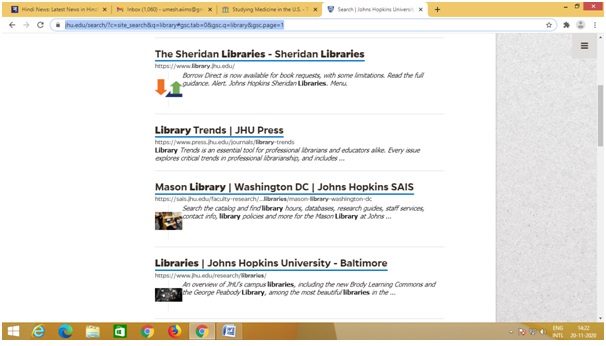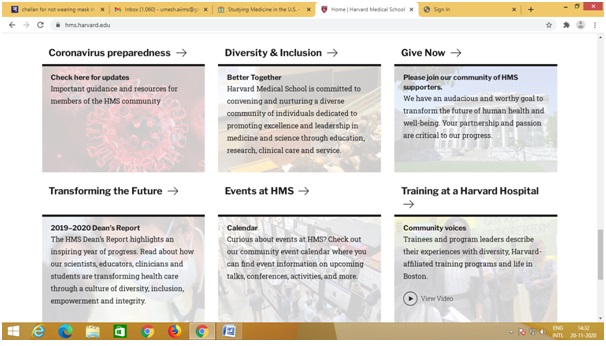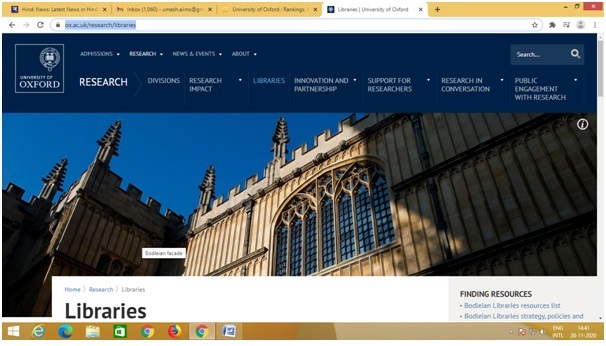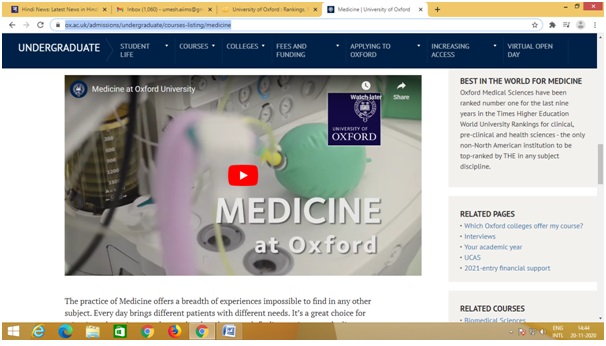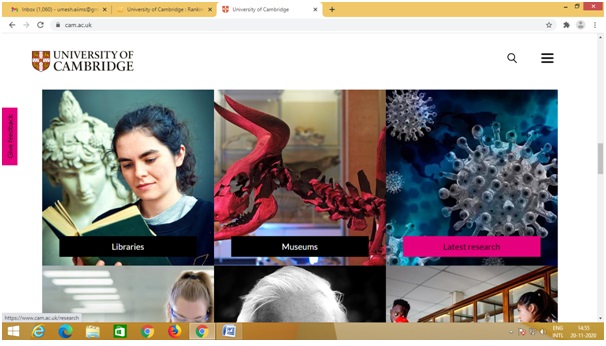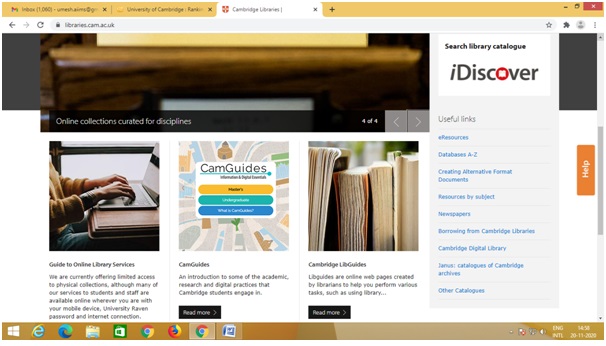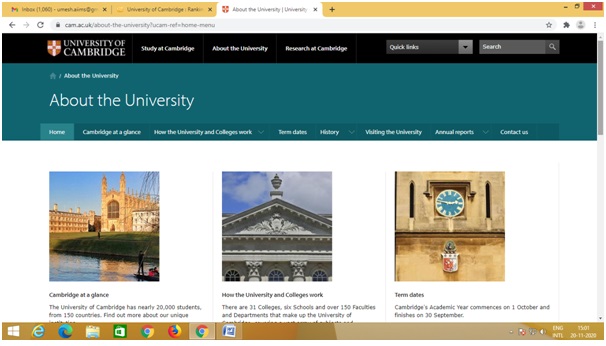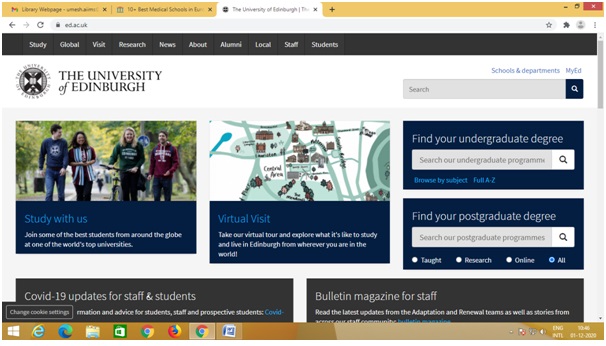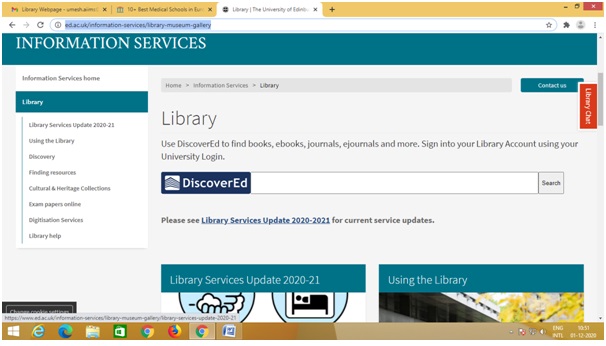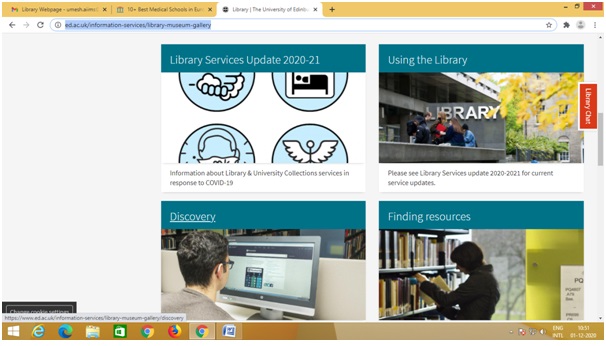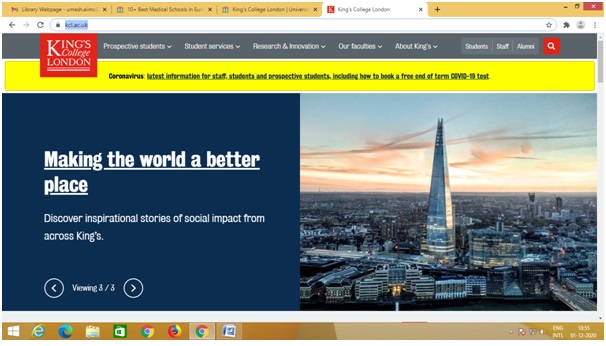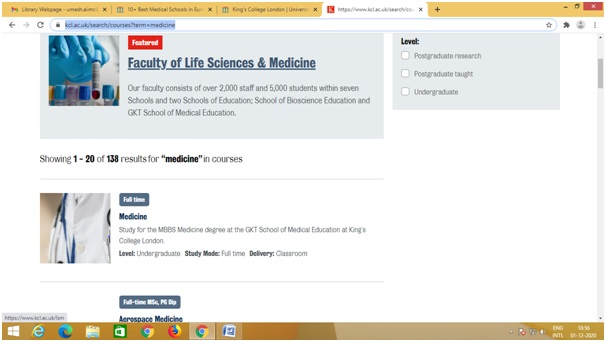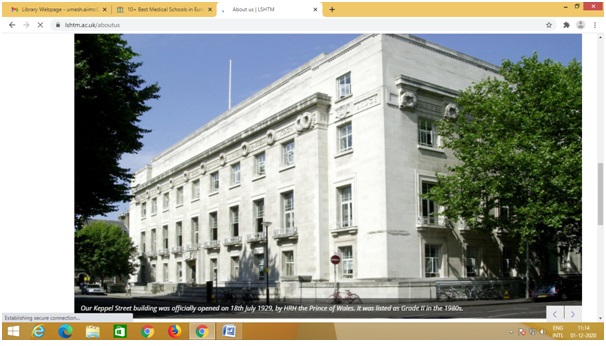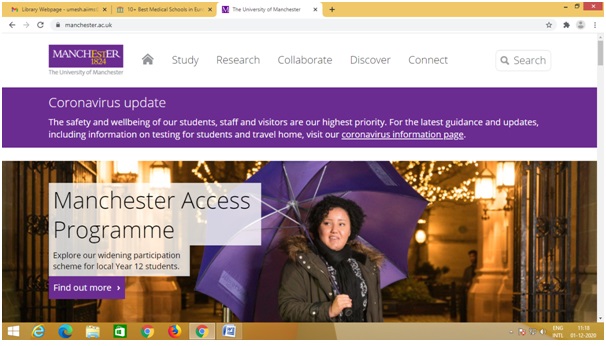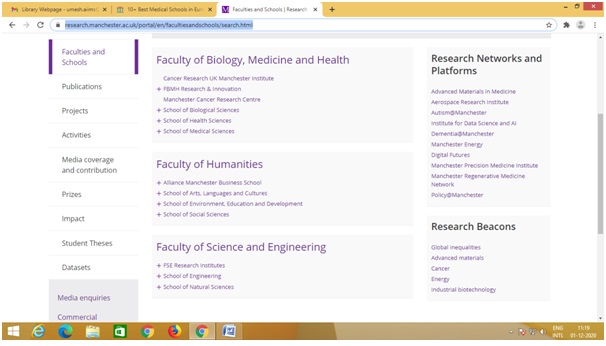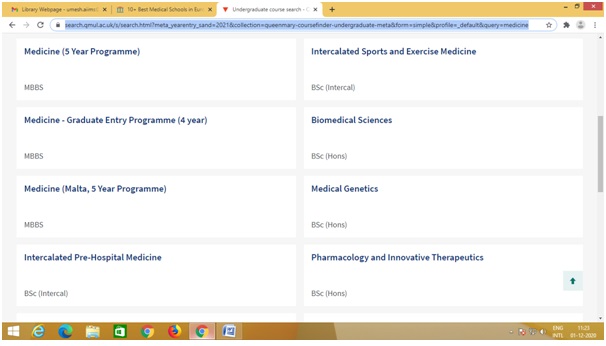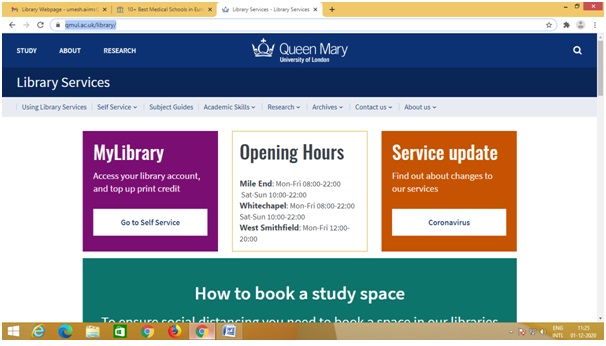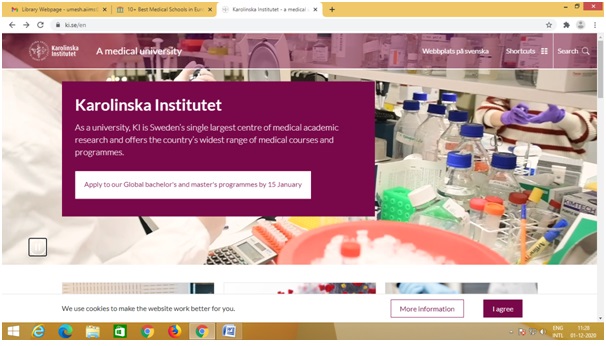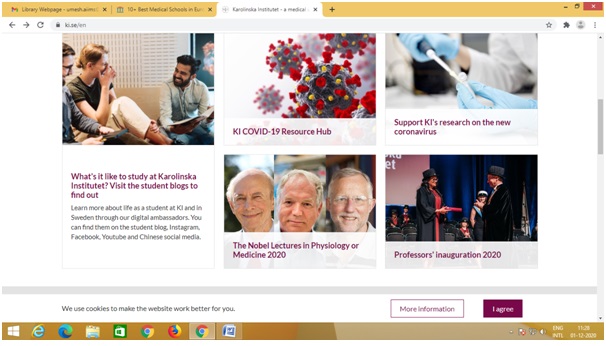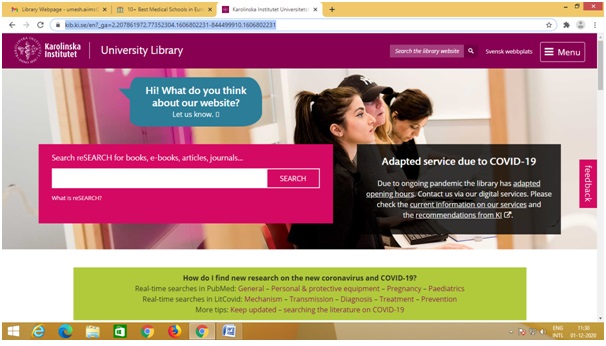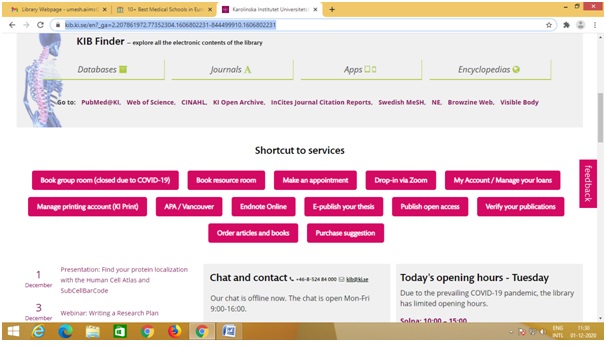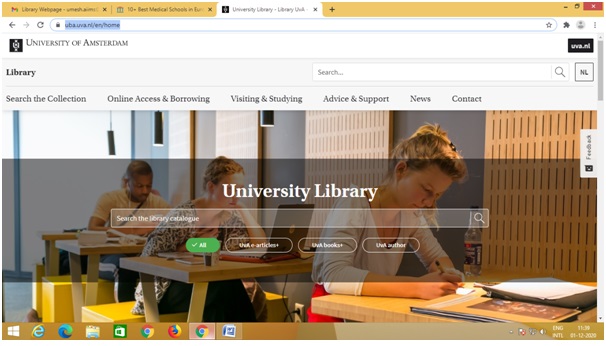International Medical Health Libraries
- Last Updated On :
1. National Institute of Health (USA)https://www.nihlibrary.nih.gov/agency/nih
|
|
|
|
|
2. National Library of Medicine (NLM)https://www.nih.gov/about-nih/what-we-do/nih-almanac/national-library-medicine-nlm
|
|
|
|
|
Mission
|
|
|
3.Johns Hopkins University |
|
|
|
|
|
https://www.hopkinsmedicine.org/som/education-programs/academic-departments.html
|
|
|
https://www.jhu.edu/search/?c=site_search&q=library#gsc.tab=0&gsc.q=library&gsc.page=1
|
|
|
“What are we aiming at?” That’s the question our university’s first president, Daniel Coit Gilman, asked at his inauguration in 1876. What is this place all about, exactly? His answer: “The encouragement of research . . . and the advancement of individual scholars, who by their excellence will advance the sciences they pursue, and the society where they dwell.” Gilman believed that teaching and research go hand in hand—that success in one depends on success in the other—and that a modern university must do both well. He also believed that sharing our knowledge and discoveries would help make the world a better place. In 140 years, we haven’t strayed from that vision. This is still a destination for excellent, ambitious scholars and a world leader in teaching and research. Distinguished professors mentor students in the arts and music, humanities, social and natural sciences, engineering, international studies, education, business, and the health professions. Those same faculty members, along with their colleagues at the university’s Applied Physics Laboratory, have made us the nation’s leader in federal research and development funding every year since 1979. That’s a fitting distinction for America’s first research university, a place that has revolutionized higher education in the U.S. and continues to bring knowledge and discoveries to the world. https://www.jhu.edu/about/history/ The university takes its name from 19th-century Maryland philanthropist Johns Hopkins, an entrepreneur and abolitionist with Quaker roots who believed in improving public health and education in Baltimore and beyond. Mr. Hopkins, one of 11 children, made his fortune in the wholesale business and by investing in emerging industries, notably the Baltimore and Ohio Railroad, of which he became a director in 1847. In his will, he set aside $7 million to establish a hospital and affiliated training colleges, an orphanage, and a university. At the time, it was the largest philanthropic bequest in U.S. history. Johns Hopkins University opened in 1876 with the inauguration of our first president, Daniel Coit Gilman. He guided the opening of the university and other institutions, including the university press, the hospital, and the schools of nursing and medicine. The original academic building on the Homewood campus, Gilman Hall, is named in his honor. “Our simple aim is to make scholars, strong, bright, useful, and true,” Gilman said in his inaugural address. In the speech, he defined the model of the American research university, now emulated around the globe. The mission he described then remains the university’s mission today: To educate its students and cultivate their capacity for lifelong learning, to foster independent and original research, and to bring the benefits of discovery to the world. Or, summed up in a simple but powerful restatement of Gilman’s own words: “Knowledge for the world.”
|
|
Education
|
|
|
|
|
|
|
https://hms.harvard.edu/about-hms/hms-affiliates
|
|
5. Oxford University |
|
|
|
https://www.ox.ac.uk/admissions/undergraduate/courses-listing/medicine
|
|
|
|
Libraries Oxford meets the needs of its students, academics and the international research community with a wide range of library services provided by more than 100 libraries, making it the largest library system in the UK.Bodleian Libraries Have you ever wondered what it's like to study in the Bodleian? Tune in and listen to the sounds of Oxford's most famous libraries. Is the University’s main research library and a legal deposit library. It is the second largest in the UK after the British Library. Visit the Bodleian Library website. College libraries Oxford University Libraries A-ZThe University also houses many departmental and museum libraries, such as the Museum of the History of Science Library and the Oxford University Museum of Natural History Library. Further information on all University libraries can be found using the 'Libraries A-Z' or ‘Subjects A-Z’ indexes. Finding resourcesSOLO (Search Oxford Libraries Online) is the main search engine for library collections across Oxford, providing access to information in over 100 Oxford libraries including circa eight million bibliographic records and more than 13 million item records. It offers a one-stop search and delivery solution for quickly accessing Oxford’s main library information resources regardless of type, format or location. These include ORA (Oxford University Research Archive), OxLIP+ (currently over 800 e-resource databases) and OU E-Journals (over 28,000 e-journals). Single Sign-On offers easy access to subscription resources, whether on or off campus. Visit the SOLO website. Find more information on finding resources at the Bodleian Libraries. Digital projects and servicesThe Bodleian is actively involved in developing new digital collections and services in close collaboration with students, researchers, and staff from around the University. To learn more about these services please see this overview or have a look at a selection of our past or current projects.
The practice of Medicine offers a breadth of experiences impossible to find in any other subject. Every day brings different patients with different needs. It’s a great choice for scientists who strive to understand and apply research findings to improve the lives of the patients in their care. It offers a meaningful career that is prestigious, secure and well paid. However, practising Medicine can be arduous, stressful, frustrating and bureaucratic and is not suited to everyone. You need to be sure that Medicine is the right choice for you. These pages will help you work that out, but there’s no better way to find out for sure than by gaining insight into medical practice by seeing it in action and talking to those who provide healthcare. Studying Medicine because that is what is expected of you is never a good idea; make sure that your motives for choosing to do so are well reasoned. The Medicine course at Oxford provides a well-rounded intellectual training with particular emphasis on the basic science research that underpins medicine. We have retained a distinct three-year pre-clinical stage that includes studying towards a BA Honours degree in Medical Sciences, followed by a three-year clinical stage. The Medical School at Oxford is relatively small, allowing students and staff to get to know one another and benefit from a relaxed and friendly atmosphere. Research work All A100 students at Oxford undertake an experimental research project as part of their BA in Medical Sciences. This will be in a field of interest to the student, and will offer valuable first-hand experience of scientific research. Students have the opportunity to undertake research in a laboratory from a wide range of departments within the Medical Sciences Division.
|
|
|
6. University of Cambridge
|
|
|
|
|
|
|
|
|
7. The University of Edinburgh https://www.ed.ac.uk/information-services/library-museum-gallery
|
|
|
|
|
|
https://www.ed.ac.uk/information-services/library-museum-gallery
|
|
Our historyWith our rich history, noted alumni and distinguished scholars, we have much to be proud of in our many centuries as a world-renowned university. From Nobel laureates and Olympic champions to space explorers and prime ministers, the University of Edinburgh has been influencing history since it opened the gates to its first students in 1583. Ground-breaking thinkersFollowing the Scottish Enlightenment of the 18th century, the University was positioned at the forefront of academia and critical thinking. Due to the determination and perseverance of a group of Edinburgh intellectuals, established facts about the world were being boldly and consistently challenged. Amid this group was David Hume, philosopher, economist and essayist known for his philosophical skepticism and empiricism; Joseph Black, the chemist behind the discovery of latent heat and carbon dioxide; and James Hutton, the ‘Father of Modern Geology’. Shaping the past, the present and the futureWe are the home of Britain’s oldest literary awards, the James Tait Black Prizes and Dolly the sheep, the first animal to be cloned from an adult somatic cell. It was also here at the University of Edinburgh that Sir Arthur Conan Doyle was inspired to create his notorious character, Sherlock Holmes and James Young Simpson pioneered anaesthetics through his discovery of the properties of chloroform. More recently, theoretical physicist and Professor Emeritus Peter Higgs was jointly awarded the Nobel Prize in Physics for his 1964 prediction of the Higgs Boson. Through the many achievements of its staff and students, the University has continued to present cutting-edge research, inspirational teaching and innovative thinking as its central ethos, attracting some of the greatest minds from around the globe. Libraryhttps://www.ed.ac.uk/information-services/library-museum-gallery 25 Aug 2020: Library services at the University of Edinburgh Library serviceshttps://www.ed.ac.uk/alumni/services/benefits/stay-connected/library 21 Sep 2020: Use the vast resources of the Main Library and and all site libraries after graduation by registering for alumni library membership. https://www.ed.ac.uk/students/new-students/online-students/using-the-library 29 Jun 2020: As an online student you will have remote access to one of the world's biggest academic libraries. Information Serviceshttps://www.ed.ac.uk/information-services 18 Sep 2020: INFORMATION SERVICES Campus mapshttps://www.ed.ac.uk/maps/maps 16 Aug 2019: Search and find University buildings with our campus map search tool. Accessing the Libraryhttps://www.ed.ac.uk/studying/online-learning/postgraduate/support-resources/library 12 Jun 2020: As an online learner, you will have access to an extensive range of e-books, ejournals and databases which you can use while studying. New College Libraryhttps://www.ed.ac.uk/divinity/about/library-announcement 20 Jan 2020: Founded in 1843 as the Library of the Free Church College, and now serving the School of Divinity, it is one of the largest theology libraries in the UK, with around a quarter of a million items and a large and rich manuscript collection, including Library Services Update 2020-21https://www.ed.ac.uk/information-services/library-museum-gallery/library-services-update-2020-21 23 Nov 2020: Information and updates about Library & University Collections services in response to COVID-19 Main Libraryhttps://www.ed.ac.uk/information-services/library-museum-gallery/using-library/lib-locate/main-lib 12 Oct 2020: Guide to location of and information about access to the University Main Library Library locationshttps://www.ed.ac.uk/information-services/library-museum-gallery/using-library/lib-locate 03 Nov 2020: Overview of Edinburgh University Library locations.·
|
|
|
8. Kings College London
|
|
|
|
https://www.kcl.ac.uk/search/courses?term=medicine
|
|
|
|
|
9. The University of Glasgow (Scotland) UK https://www.gla.ac.uk/myglasgow/library/
|
|
|
|
|
|
10. The London School of Hygiene & Tropical Medicine
|
|
|
|
https://www.lshtm.ac.uk/research/library-archives-service/using-library
|
Renewing loansUnless recalled, standard loans and key texts will be automatically renewed for students (up to 12 weeks) and staff (up to 24 weeks). Overdue items must be returned immediately. External Members are not able to renew items. Using other librariesUsers have access to a wide variety of other libraries if the material they need is not available at the School. Items that are not held in nearby libraries can be ordered through the Library's Inter Library Loans Service. For information about the Inter Library Loans service, see the Library intranet pages. University of London Senate House Library Other UK Universities Academic staff are given membership for 3 years or until the end of their current contract. Students are given membership until their LSHTM library account expiry date. When staff and students leave LSHTM, their SCONUL Access membership is revoked. During vacation times, taught course students of the School can use other university libraries for reference via the SCONUL Summer Vacation Access Scheme. British Library King's Fund Staff and studentsFor remote access, training and booking of any facilities see the Library intranet pages.
|
|
|
11. University of Manchester UK
|
|
|
|
https://www.research.manchester.ac.uk/portal/en/facultiesandschools/search.html
|
|
|
|
|
12. Queen Mary University of London
|
|
|
|
|
|
|
|
|
13. Karolinska Institute, Sweden
|
|
|
|
|
|
|
|
|
14. Heidelberg University, Germany https://www.uni-heidelberg.de/en
|
|
|
|
|
15. University of Amsterdam, the Netherlands
|
|
|
|
|
|
|
|











